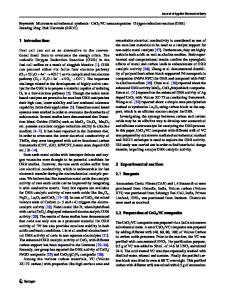Rational design of highly efficient metal-polyaniline/carbon cloth catalyst towards enhanced oxygen reduction reaction
- PDF / 2,092,900 Bytes
- 9 Pages / 595.276 x 790.866 pts Page_size
- 27 Downloads / 344 Views
ORIGINAL PAPER
Rational design of highly efficient metal-polyaniline/carbon cloth catalyst towards enhanced oxygen reduction reaction Xinping He 1 & Shuai Ruan 1 & Yun Chen 1 & Jun Zhang 1 & Chu Liang 1 & Hui Huang 1 & Yongping Gan 1 & Wenkui Zhang 1 & Yang Xia 1 Received: 31 May 2020 / Revised: 4 June 2020 / Accepted: 13 June 2020 # Springer-Verlag GmbH Germany, part of Springer Nature 2020
Abstract The key to sustainable energy application is the rational utilization of abundant materials on the earth. Fe, Co, and Cu theoretically exhibit high oxygen reduction capability close to Pt. However, their high diffusion behaviors make it difficult to homogeneously incorporate with carbon at elevated fabrication temperature. Here, polyaniline is developed an incorporated frame to realize the homodisperse of Fe, Co, or Cu. Three efficient oxygen reduction catalysts, including Fe-polyaniline/carbon (Fe-N/C), Co-N/C, and Cu-N/C are synthesized by a three-step method combining polymerization, complexation, and pyrolysis. All catalysts with metal doping reveal high catalytic activity, good cyclic stability, and the activity varies with different doping metal. The Fe-doped catalyst exhibits the best oxygen reduction ability with onset and half-wave potentials of − 104 mV and − 199.5 mV. Furthermore, the influence of complexation time and the pyrolysis temperature on the oxygen reduction activity are also studied systematically. These interesting discoveries may contribute to provide important ideas to oxygen reduction catalysts. Keywords Metal-doping . Nanocomposite . Catalyst . Oxygen reduction reaction . Fuel cells
Introduction Fuel cells and metal-air batteries are considered to be environment friendly new energy systems [1]. The extensive commercialization of them greatly depends on the design of highly efficient electrocatalysts for oxygen reduction reaction (ORR) [2, 3]. Up to now, owing to ORR is sluggish in kinetics; Pt and its alloys are the most popular commercial catalysts [4–6]. However, the high cost, scarcity, and low tolerance to fuel crossover of them severely restrict the practical application. Therefore, the substitution of Pt based catalysts is the essential research for commercialization [7].
Electronic supplementary material The online version of this article (https://doi.org/10.1007/s11581-020-03666-7) contains supplementary material, which is available to authorized users. * Wenkui Zhang [email protected] * Yang Xia [email protected] 1
College of Materials Science and Engineering, Zhejiang University of Technology, Hangzhou 310014, China
Fuel cell consists of anode, cathode, electrolyte and external circuits. The ORR on the cathode is a critical reaction since it is directly related to the efficiency of energy conversion [8, 9]. In recent years, great effort has been made for non-Pt catalyst cathode, such as non-precious metal catalysts, metal-free catalysts, and metal-nitrogen/carbon (M-N/C) catalyst [10–14]. In view of abundant resources, ORR activity, stability, and good methanol poisoning
Data Loading...











